Analyzing State's Role in Public Health Regulations: A Theory Review
VerifiedAdded on 2023/06/15
|6
|1447
|456
Essay
AI Summary
This essay delves into the role of the state in public health regulations, emphasizing the importance of government involvement in improving public health through various norms and values. It highlights the Public Health Agency of Canada's objectives, including disease prevention, health promotion, and information dissemination. The essay further examines the public interest theory, which advocates for efficient resource allocation through government regulation to address market imperfections and information problems. It also discusses the private interest theory, suggesting that regulations can be influenced by industry interests. The dynamic capture theories are introduced to explain the evolving relationship between regulatory agencies and the entities they regulate. The essay concludes that public health regulations are crucial for addressing health hazards and that understanding both public and private interest theories is essential for effective regulatory practices. Desklib offers a platform for students to access similar solved assignments and past papers.
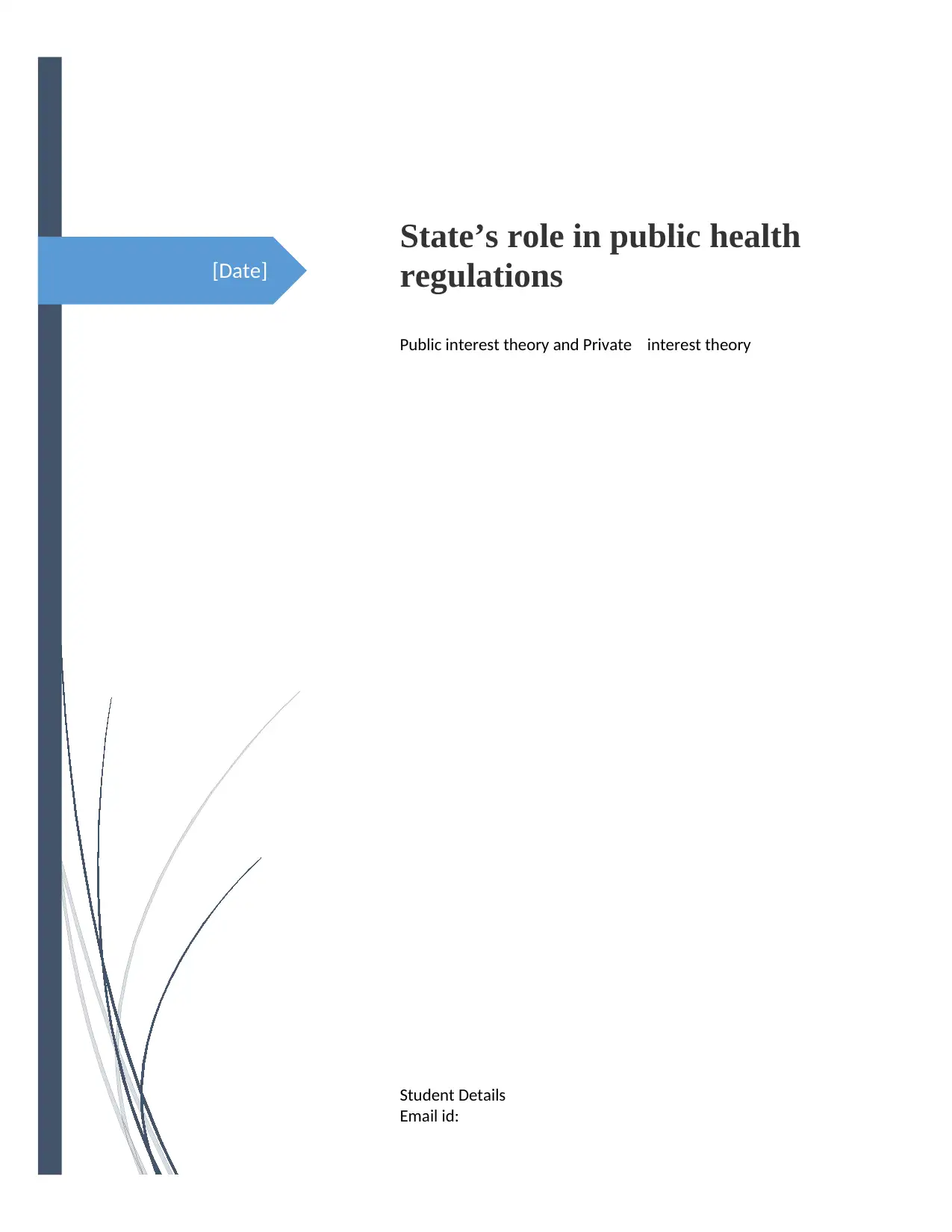
[Date]
State’s role in public health
regulations
Public interest theory and Private interest theory
Student Details
Email id:
State’s role in public health
regulations
Public interest theory and Private interest theory
Student Details
Email id:
Paraphrase This Document
Need a fresh take? Get an instant paraphrase of this document with our AI Paraphraser
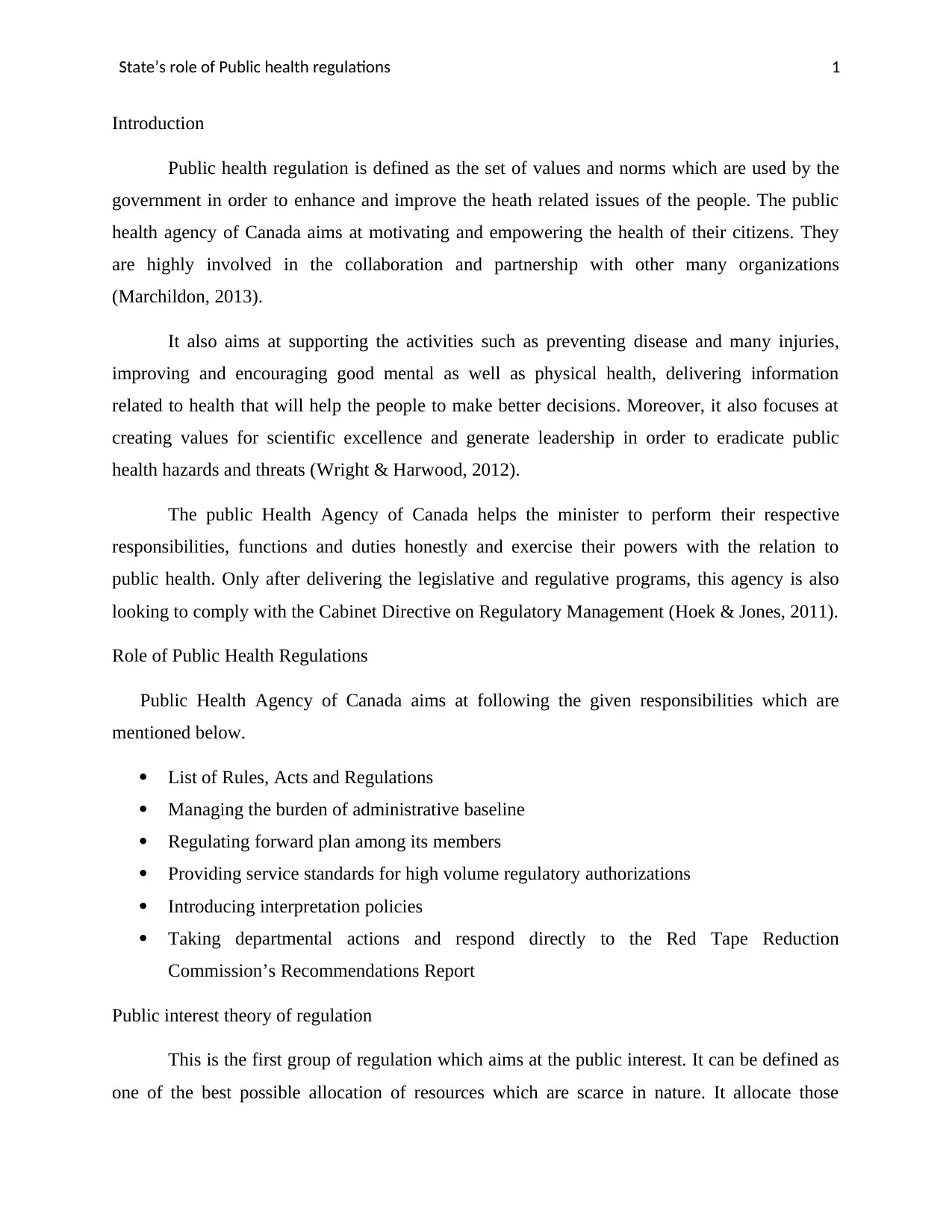
State’s role of Public health regulations 1
Introduction
Public health regulation is defined as the set of values and norms which are used by the
government in order to enhance and improve the heath related issues of the people. The public
health agency of Canada aims at motivating and empowering the health of their citizens. They
are highly involved in the collaboration and partnership with other many organizations
(Marchildon, 2013).
It also aims at supporting the activities such as preventing disease and many injuries,
improving and encouraging good mental as well as physical health, delivering information
related to health that will help the people to make better decisions. Moreover, it also focuses at
creating values for scientific excellence and generate leadership in order to eradicate public
health hazards and threats (Wright & Harwood, 2012).
The public Health Agency of Canada helps the minister to perform their respective
responsibilities, functions and duties honestly and exercise their powers with the relation to
public health. Only after delivering the legislative and regulative programs, this agency is also
looking to comply with the Cabinet Directive on Regulatory Management (Hoek & Jones, 2011).
Role of Public Health Regulations
Public Health Agency of Canada aims at following the given responsibilities which are
mentioned below.
List of Rules, Acts and Regulations
Managing the burden of administrative baseline
Regulating forward plan among its members
Providing service standards for high volume regulatory authorizations
Introducing interpretation policies
Taking departmental actions and respond directly to the Red Tape Reduction
Commission’s Recommendations Report
Public interest theory of regulation
This is the first group of regulation which aims at the public interest. It can be defined as
one of the best possible allocation of resources which are scarce in nature. It allocate those
Introduction
Public health regulation is defined as the set of values and norms which are used by the
government in order to enhance and improve the heath related issues of the people. The public
health agency of Canada aims at motivating and empowering the health of their citizens. They
are highly involved in the collaboration and partnership with other many organizations
(Marchildon, 2013).
It also aims at supporting the activities such as preventing disease and many injuries,
improving and encouraging good mental as well as physical health, delivering information
related to health that will help the people to make better decisions. Moreover, it also focuses at
creating values for scientific excellence and generate leadership in order to eradicate public
health hazards and threats (Wright & Harwood, 2012).
The public Health Agency of Canada helps the minister to perform their respective
responsibilities, functions and duties honestly and exercise their powers with the relation to
public health. Only after delivering the legislative and regulative programs, this agency is also
looking to comply with the Cabinet Directive on Regulatory Management (Hoek & Jones, 2011).
Role of Public Health Regulations
Public Health Agency of Canada aims at following the given responsibilities which are
mentioned below.
List of Rules, Acts and Regulations
Managing the burden of administrative baseline
Regulating forward plan among its members
Providing service standards for high volume regulatory authorizations
Introducing interpretation policies
Taking departmental actions and respond directly to the Red Tape Reduction
Commission’s Recommendations Report
Public interest theory of regulation
This is the first group of regulation which aims at the public interest. It can be defined as
one of the best possible allocation of resources which are scarce in nature. It allocate those
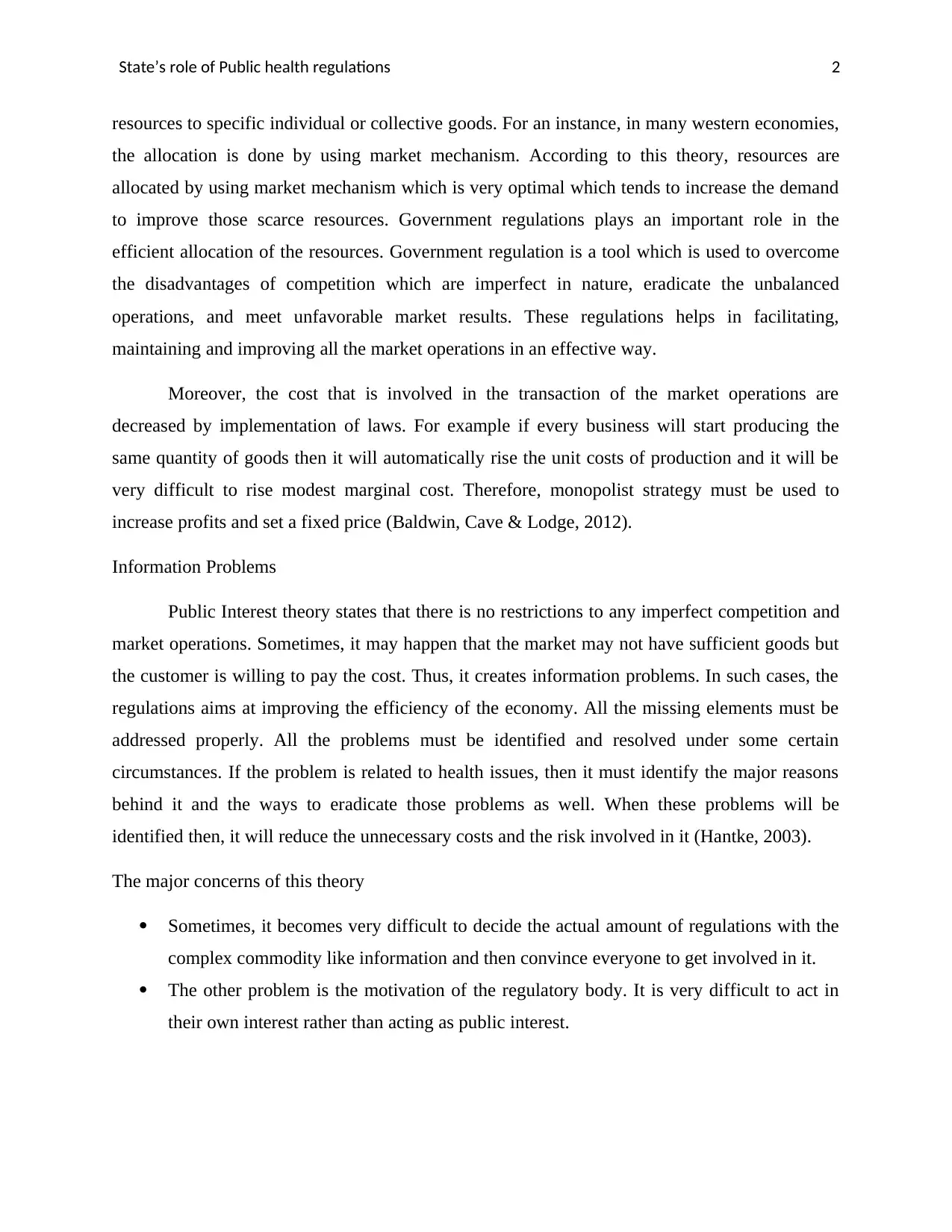
State’s role of Public health regulations 2
resources to specific individual or collective goods. For an instance, in many western economies,
the allocation is done by using market mechanism. According to this theory, resources are
allocated by using market mechanism which is very optimal which tends to increase the demand
to improve those scarce resources. Government regulations plays an important role in the
efficient allocation of the resources. Government regulation is a tool which is used to overcome
the disadvantages of competition which are imperfect in nature, eradicate the unbalanced
operations, and meet unfavorable market results. These regulations helps in facilitating,
maintaining and improving all the market operations in an effective way.
Moreover, the cost that is involved in the transaction of the market operations are
decreased by implementation of laws. For example if every business will start producing the
same quantity of goods then it will automatically rise the unit costs of production and it will be
very difficult to rise modest marginal cost. Therefore, monopolist strategy must be used to
increase profits and set a fixed price (Baldwin, Cave & Lodge, 2012).
Information Problems
Public Interest theory states that there is no restrictions to any imperfect competition and
market operations. Sometimes, it may happen that the market may not have sufficient goods but
the customer is willing to pay the cost. Thus, it creates information problems. In such cases, the
regulations aims at improving the efficiency of the economy. All the missing elements must be
addressed properly. All the problems must be identified and resolved under some certain
circumstances. If the problem is related to health issues, then it must identify the major reasons
behind it and the ways to eradicate those problems as well. When these problems will be
identified then, it will reduce the unnecessary costs and the risk involved in it (Hantke, 2003).
The major concerns of this theory
Sometimes, it becomes very difficult to decide the actual amount of regulations with the
complex commodity like information and then convince everyone to get involved in it.
The other problem is the motivation of the regulatory body. It is very difficult to act in
their own interest rather than acting as public interest.
resources to specific individual or collective goods. For an instance, in many western economies,
the allocation is done by using market mechanism. According to this theory, resources are
allocated by using market mechanism which is very optimal which tends to increase the demand
to improve those scarce resources. Government regulations plays an important role in the
efficient allocation of the resources. Government regulation is a tool which is used to overcome
the disadvantages of competition which are imperfect in nature, eradicate the unbalanced
operations, and meet unfavorable market results. These regulations helps in facilitating,
maintaining and improving all the market operations in an effective way.
Moreover, the cost that is involved in the transaction of the market operations are
decreased by implementation of laws. For example if every business will start producing the
same quantity of goods then it will automatically rise the unit costs of production and it will be
very difficult to rise modest marginal cost. Therefore, monopolist strategy must be used to
increase profits and set a fixed price (Baldwin, Cave & Lodge, 2012).
Information Problems
Public Interest theory states that there is no restrictions to any imperfect competition and
market operations. Sometimes, it may happen that the market may not have sufficient goods but
the customer is willing to pay the cost. Thus, it creates information problems. In such cases, the
regulations aims at improving the efficiency of the economy. All the missing elements must be
addressed properly. All the problems must be identified and resolved under some certain
circumstances. If the problem is related to health issues, then it must identify the major reasons
behind it and the ways to eradicate those problems as well. When these problems will be
identified then, it will reduce the unnecessary costs and the risk involved in it (Hantke, 2003).
The major concerns of this theory
Sometimes, it becomes very difficult to decide the actual amount of regulations with the
complex commodity like information and then convince everyone to get involved in it.
The other problem is the motivation of the regulatory body. It is very difficult to act in
their own interest rather than acting as public interest.
⊘ This is a preview!⊘
Do you want full access?
Subscribe today to unlock all pages.

Trusted by 1+ million students worldwide
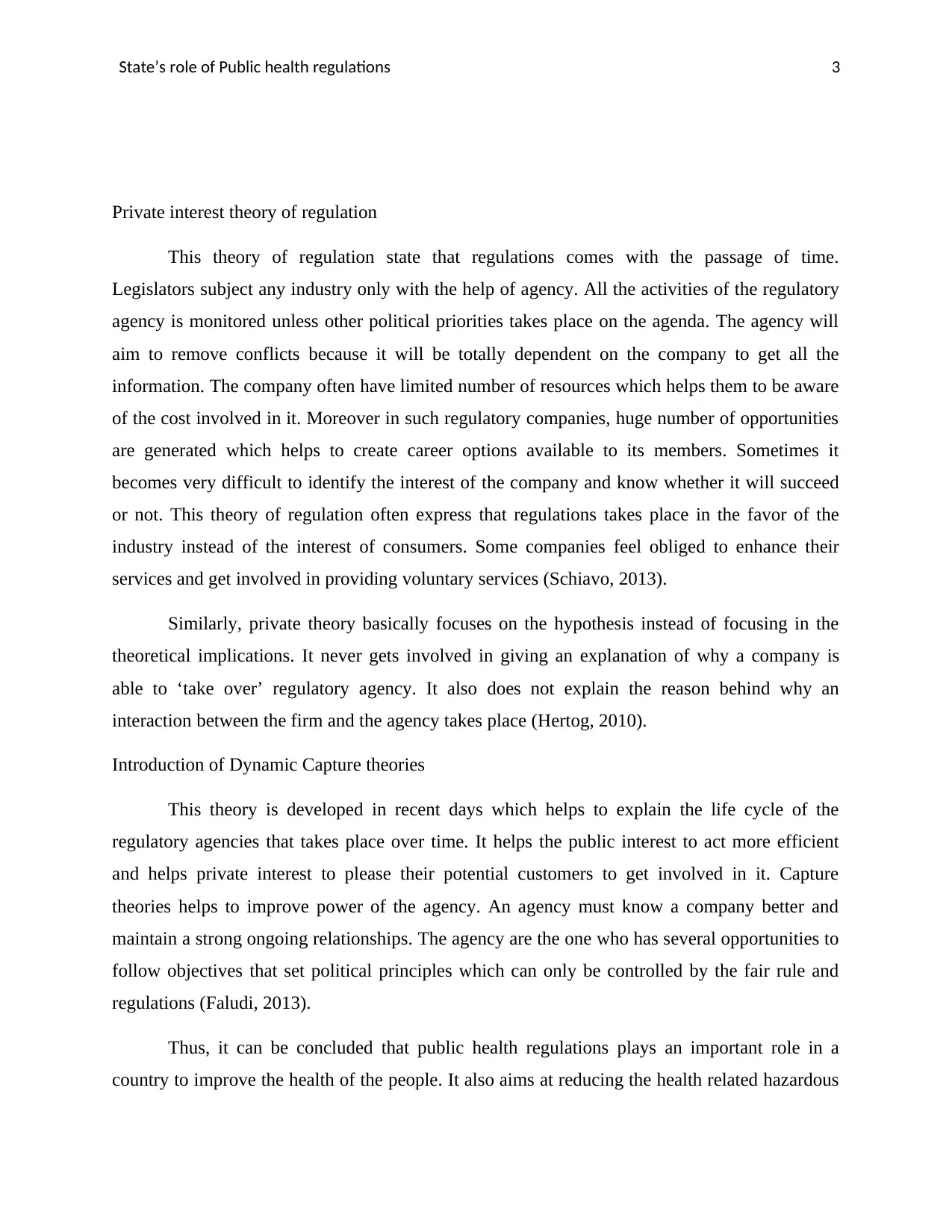
State’s role of Public health regulations 3
Private interest theory of regulation
This theory of regulation state that regulations comes with the passage of time.
Legislators subject any industry only with the help of agency. All the activities of the regulatory
agency is monitored unless other political priorities takes place on the agenda. The agency will
aim to remove conflicts because it will be totally dependent on the company to get all the
information. The company often have limited number of resources which helps them to be aware
of the cost involved in it. Moreover in such regulatory companies, huge number of opportunities
are generated which helps to create career options available to its members. Sometimes it
becomes very difficult to identify the interest of the company and know whether it will succeed
or not. This theory of regulation often express that regulations takes place in the favor of the
industry instead of the interest of consumers. Some companies feel obliged to enhance their
services and get involved in providing voluntary services (Schiavo, 2013).
Similarly, private theory basically focuses on the hypothesis instead of focusing in the
theoretical implications. It never gets involved in giving an explanation of why a company is
able to ‘take over’ regulatory agency. It also does not explain the reason behind why an
interaction between the firm and the agency takes place (Hertog, 2010).
Introduction of Dynamic Capture theories
This theory is developed in recent days which helps to explain the life cycle of the
regulatory agencies that takes place over time. It helps the public interest to act more efficient
and helps private interest to please their potential customers to get involved in it. Capture
theories helps to improve power of the agency. An agency must know a company better and
maintain a strong ongoing relationships. The agency are the one who has several opportunities to
follow objectives that set political principles which can only be controlled by the fair rule and
regulations (Faludi, 2013).
Thus, it can be concluded that public health regulations plays an important role in a
country to improve the health of the people. It also aims at reducing the health related hazardous
Private interest theory of regulation
This theory of regulation state that regulations comes with the passage of time.
Legislators subject any industry only with the help of agency. All the activities of the regulatory
agency is monitored unless other political priorities takes place on the agenda. The agency will
aim to remove conflicts because it will be totally dependent on the company to get all the
information. The company often have limited number of resources which helps them to be aware
of the cost involved in it. Moreover in such regulatory companies, huge number of opportunities
are generated which helps to create career options available to its members. Sometimes it
becomes very difficult to identify the interest of the company and know whether it will succeed
or not. This theory of regulation often express that regulations takes place in the favor of the
industry instead of the interest of consumers. Some companies feel obliged to enhance their
services and get involved in providing voluntary services (Schiavo, 2013).
Similarly, private theory basically focuses on the hypothesis instead of focusing in the
theoretical implications. It never gets involved in giving an explanation of why a company is
able to ‘take over’ regulatory agency. It also does not explain the reason behind why an
interaction between the firm and the agency takes place (Hertog, 2010).
Introduction of Dynamic Capture theories
This theory is developed in recent days which helps to explain the life cycle of the
regulatory agencies that takes place over time. It helps the public interest to act more efficient
and helps private interest to please their potential customers to get involved in it. Capture
theories helps to improve power of the agency. An agency must know a company better and
maintain a strong ongoing relationships. The agency are the one who has several opportunities to
follow objectives that set political principles which can only be controlled by the fair rule and
regulations (Faludi, 2013).
Thus, it can be concluded that public health regulations plays an important role in a
country to improve the health of the people. It also aims at reducing the health related hazardous
Paraphrase This Document
Need a fresh take? Get an instant paraphrase of this document with our AI Paraphraser
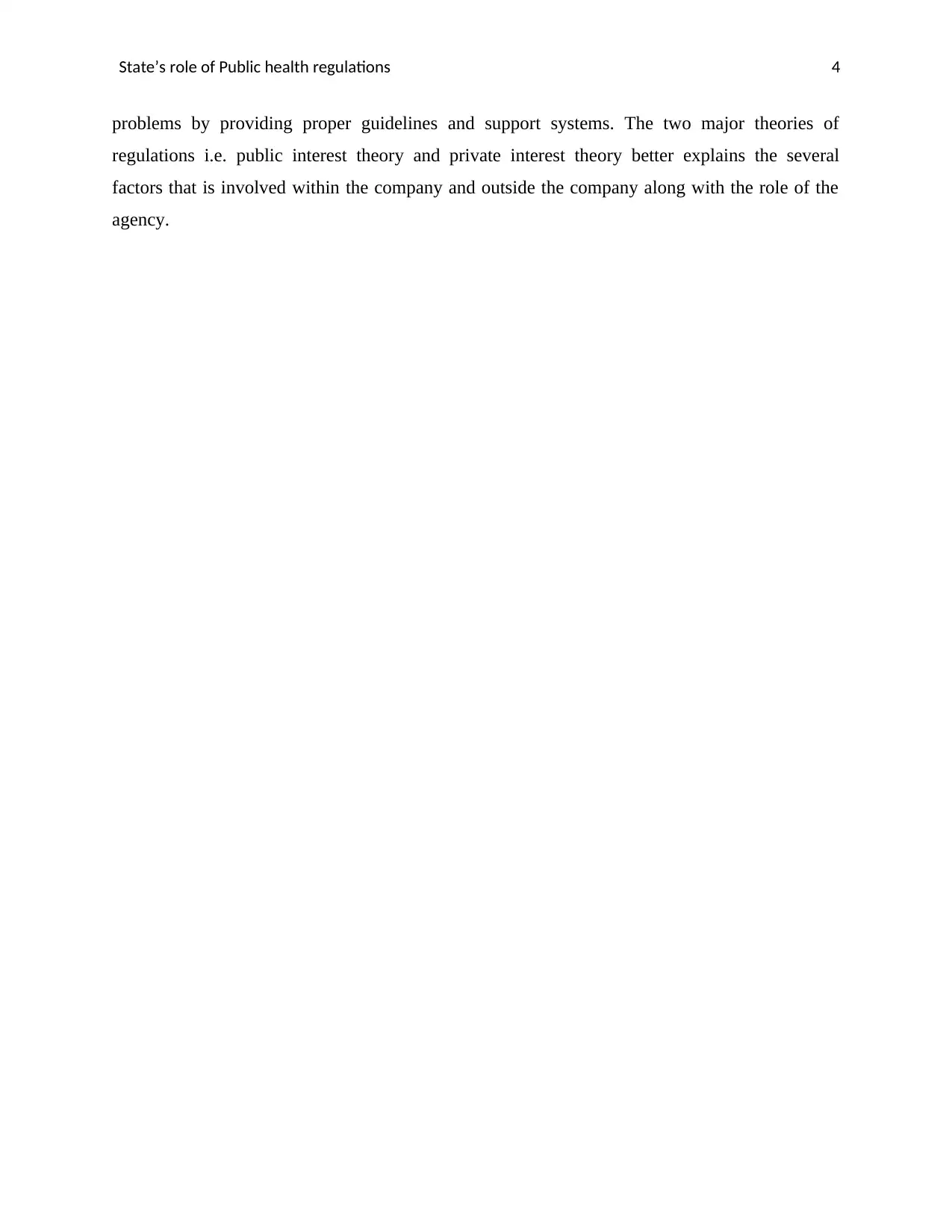
State’s role of Public health regulations 4
problems by providing proper guidelines and support systems. The two major theories of
regulations i.e. public interest theory and private interest theory better explains the several
factors that is involved within the company and outside the company along with the role of the
agency.
problems by providing proper guidelines and support systems. The two major theories of
regulations i.e. public interest theory and private interest theory better explains the several
factors that is involved within the company and outside the company along with the role of the
agency.
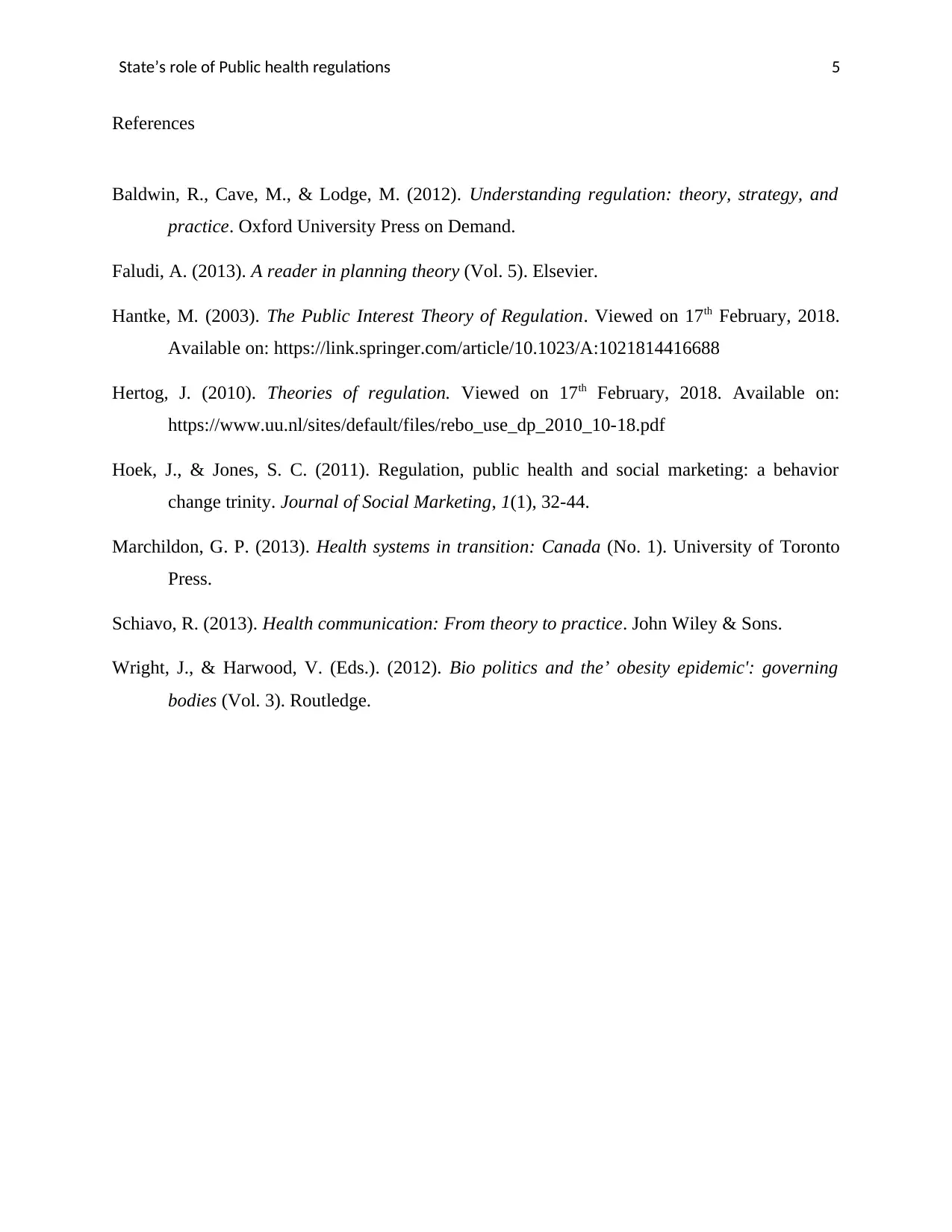
State’s role of Public health regulations 5
References
Baldwin, R., Cave, M., & Lodge, M. (2012). Understanding regulation: theory, strategy, and
practice. Oxford University Press on Demand.
Faludi, A. (2013). A reader in planning theory (Vol. 5). Elsevier.
Hantke, M. (2003). The Public Interest Theory of Regulation. Viewed on 17th February, 2018.
Available on: https://link.springer.com/article/10.1023/A:1021814416688
Hertog, J. (2010). Theories of regulation. Viewed on 17th February, 2018. Available on:
https://www.uu.nl/sites/default/files/rebo_use_dp_2010_10-18.pdf
Hoek, J., & Jones, S. C. (2011). Regulation, public health and social marketing: a behavior
change trinity. Journal of Social Marketing, 1(1), 32-44.
Marchildon, G. P. (2013). Health systems in transition: Canada (No. 1). University of Toronto
Press.
Schiavo, R. (2013). Health communication: From theory to practice. John Wiley & Sons.
Wright, J., & Harwood, V. (Eds.). (2012). Bio politics and the’ obesity epidemic': governing
bodies (Vol. 3). Routledge.
References
Baldwin, R., Cave, M., & Lodge, M. (2012). Understanding regulation: theory, strategy, and
practice. Oxford University Press on Demand.
Faludi, A. (2013). A reader in planning theory (Vol. 5). Elsevier.
Hantke, M. (2003). The Public Interest Theory of Regulation. Viewed on 17th February, 2018.
Available on: https://link.springer.com/article/10.1023/A:1021814416688
Hertog, J. (2010). Theories of regulation. Viewed on 17th February, 2018. Available on:
https://www.uu.nl/sites/default/files/rebo_use_dp_2010_10-18.pdf
Hoek, J., & Jones, S. C. (2011). Regulation, public health and social marketing: a behavior
change trinity. Journal of Social Marketing, 1(1), 32-44.
Marchildon, G. P. (2013). Health systems in transition: Canada (No. 1). University of Toronto
Press.
Schiavo, R. (2013). Health communication: From theory to practice. John Wiley & Sons.
Wright, J., & Harwood, V. (Eds.). (2012). Bio politics and the’ obesity epidemic': governing
bodies (Vol. 3). Routledge.
⊘ This is a preview!⊘
Do you want full access?
Subscribe today to unlock all pages.

Trusted by 1+ million students worldwide
1 out of 6
Related Documents
Your All-in-One AI-Powered Toolkit for Academic Success.
+13062052269
info@desklib.com
Available 24*7 on WhatsApp / Email
![[object Object]](/_next/static/media/star-bottom.7253800d.svg)
Unlock your academic potential
Copyright © 2020–2025 A2Z Services. All Rights Reserved. Developed and managed by ZUCOL.





